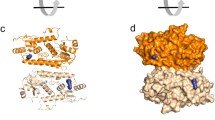Abstract
Recently, we have reported purification and characterization of a de-N-glycosylating enzyme, peptide:N-glycanase (PNGase) found in C3H mouse fibroblast L-929 cells, and designated L-929 PNGase [Suzuki T, Seko A, Kitajima K, Inoue Y, Inoue S (1994)J Biol Chem 269, 17611–18]. The unique properties of L-929 PNGase are that the enzyme had a high affinity to the substrate glycopeptide (e.g.K m=114 µm for fetuin derived glycopentapeptide) and that the PNGase-catalysed reaction is strongly inhibited by the released free oligosaccharides but not by the free peptides formed, suggesting that L-929 PNGase is able to bind to a certain type of carbohydrate chain. In this study, we report the new findings of the mannan-binding property of L-929 PNGase; the de-N-glycosylating enzyme activity of L-929 PNGase was inhibited by yeast mannan and triomannose, Manα1 → 3(Manα1 → 6)Man, but not by mannose and α-methyl-d-mannoside. Furthermore, L-929 PNGase was revealed to bind to the glycan moiety of yeast mannan by using mannan-conjugated Sepharose 4B gel as a ligand, suggesting that L-929 PNGase could serve not only as an enzyme but also as a carbohydrate recognition proteinin vivo. Such ‘dual’ properties found for animal-derived L-929 PNGase are unique and are not shared with other previously characterized plant- and bacterial-origin PNGases — PNGase A and PNGase F, respectively.
Similar content being viewed by others
Abbreviations
- GLC:
-
gas liquid chromatography
- GlcNAc-Asn:
-
2-acetamido-1-β-(l-aspartamido)-1,2-dideoxy-d-glucose
- BSA:
-
bovine serum albumin
- DTT:
-
dithiothreitol
- EDTA:
-
ethylenediaminetetraacetic acid
- Gal:
-
d-galactose
- GlcNAc:
-
N-acetyl-d-glucosamine
- Man:
-
d-mannose; triomannose, Manα1 → 3(Manα1 → 6)Man;
- MES:
-
2-(N-morphorino)ethanesulfonic acid
- NeuAc:
-
N-acetyl-neuraminic acid
- PNGase:
-
peptide:N 4-(N-accetylβ-glucosaminyl)asparagine amidase (peptide:N-glycanase,EC 3.5.1.52)
- PNP:
-
p-nitrophenyl
References
Drickamer K (1988)J Biol Chem 263:9557–60.
Drickamer K, Taylor ME (1993)Annu Rev Cell Biol 9:237–64.
Hirabayashi J (1993)Trends Glycosci Glycotechnol 5:251–70.
Goldstein IJ, Hughes RC, Monsigny M, Osawa T, Sharon N (1980)Nature 285:66.
Sharon N, Lis H (1972)Science 177:949–59.
Hoshi M, De Santis R, Pinto MR, Cotelli F, Rosati F (1985)Zool Sci 2:65–69.
Hoshi M (1986)Adv Exp Med Biol 207:251–60.
Shur BD (1989)Biochim Biophys Acta 988:389–409.
Shur BD (1991)Glycobiology 1:563–75.
Skedlarek MD, Tulsiani DRP, Nagdas SK, Orgebin-Crist M-C (1993)Biol Reprod 49:204–13.
Miller DJ, Gong X, Decker G, Shur BD (1993)J Cell Biol 123:1431–40.
Litscher ES, Wassarman PM (1993)Trends Glycosci Glycotechnol 5:369–88.
Takahashi N (1977)Biochem Biophys Res Commun 76:1194–1201.
Plummer TH Jr, Phelan AW, Tarentino AL (1987)Eur J Biochem 163:167–73.
Plummer TH Jr, Elder JH, Alexander S, Phelan AW, Tarentino AL (1984)J Biol Chem 259:10700–4.
Seko A, Kitajima K, Inoue Y, Inoue S (1991)J Biol Chem 266:22110–14.
Suzuki T, Seko A, Kitajima K, Inoue Y, Inoue S (1993)Biochem Biophys Res Commun 194:1124–30.
Suzuki T, Seko A, Kitajima K, Inoue Y, Inoue S (1993)Glycoconjugate J 10:223.
Suzuki T, Seko A, Kitajima K, Inoue Y, Inoue S (1994)J Biol Chem 269:17611–18.
Roseman S (1970)Chem Phys Lipids 5:270–97.
Nomoto H, Inoue Y (1983)Eur J Biochem 135:243–50.
Li Y-T, Li S-C (1972)Methods Enzymol 28:702–13.
Kawasaki T, Etoh R, Yamashina I (1978)Biochem Biophys Res Commun 81:1018–24.
Dubois M, Gilles KA, Hamilton JK, Rebers PA, Smith F (1956)Anal Chem 28:350–56.
Nomoto H, Iwasaki M, Endo T, Inoue S, Inoue Y, Matsumura G (1982)Arch Biochem Biophys 218:335–41.
Kitazume S, Kitajima K, Inoue S, Inoue Y (1992)Anal Biochem 202:25–34.
Maynard Y, Baenziger JU (1982)J Biol Chem 257:3788–94.
Inoue S, Iwasaki M, Seko A, Kitajima K, Inoue Y (1993)Glycoconjugate J 10:223.
Ballou CE, Lewis MS (1991)J Biol Chem 266:8255–61.
Colley KJ, Beranek MC, Baenziger JU (1988)Biochem J 256:61–68.
Ofek I, Sharon N (1990)Curr Topics Microbiol Immunol 151:91–113.
Lasky LA (1992)Science 258:964–69.
Aruffo A (1992)Trends Glycosci Glycotechnol 4:146–51.
Ashwell G, Harfold J (1982)Annu Rev Biochem 51:531–54.
Hoyle GW, Hill RL (1991)J Biol Chem 266:1850–57.
Kornfeld S (1992)Annu Rev Biochem 61:307–30.
Roth S (1973)Quart Rev Biol 48:541–63.
Rubinsky B, Coger R, Ewart KV, Fletcher GL (1992)Nature 360:113–14.
Schweinle JE, Nishiyasu M, Ding TQ, Sastry K, Gilles SD, Ezekowitz AB (1993)J Biol Chem 268:364–70.
Horstkorte R, Schachner M, Magyar JP, Vorherr T, Schmitz B (1993)J Cell Biol 121:1409–21.
Lucas R, Magez S, De Leys R, Fransen L, Scheerlinck J-P, Rampelberg M, Sablon E, De Baestselier P (1994)Science 263:814–17.
Ackerman SJ, Corrette SE, Rosenberg HF, Bennett JC, Mastrianni DM, Nicholson-Weller A, Weller F, Chin DT, Tenen DG (1993)J Immunol 150:456–68.
Wen D, Dittman WA, Ye RD, Deaven LL, Majerus PW, Sadler JE (1987)Biochemistry 26:4350–57.
Nakayama E, Von Hogen I, Parnes JR (1989)Proc. Natl Acad Sci USA 86:1352–56.
Rouquier S, Verdier J-M, Iovanna J, Dagorn J-C, Giorgi D (1991)J Biol Chem 266:786–91.
Takeya H, Nishida S, Miyata T, Kawada S, Saisaka Y, Morita T, Iwanaga S (1992)J Biol Chem 267:14109–17.
Seko A, Kitajima K, Iwasaki M, Inoue S, Inoue Y (1989)J Biol Chem 264:15922–29.
Seko A, Kitajima K, Inoue S, Inoue Y (1991)Biochem Biophys Res Commun 180:1165–71.
Richard M, Martin A, Louisot P (1975)Biochem Biophys Res Commun 64:109–14.
Shaper NL, Hollis GF, Douglas JG, Kirsch IR, Shaper JH (1988)J Biol Chem 263:10420–28.
Gonzalez-Yanes B, Cicero JM, Brown RD Jr, West CM (1992)J Biol Chem 267:9595–605.
Haeuw J-F, Michalski J-C, Strecker G, Spik G, Montreuil J (1991)Glycobiology 1:487–92.
Author information
Authors and Affiliations
Rights and permissions
About this article
Cite this article
Suzuki, T., Kitajima, K., Inoue, S. et al. Does an animal peptide:N-glycanase have the dual role as an enzyme and a carbohydrate-binding protein?. Glycoconjugate J 11, 469–476 (1994). https://doi.org/10.1007/BF00731283
Received:
Revised:
Issue Date:
DOI: https://doi.org/10.1007/BF00731283




